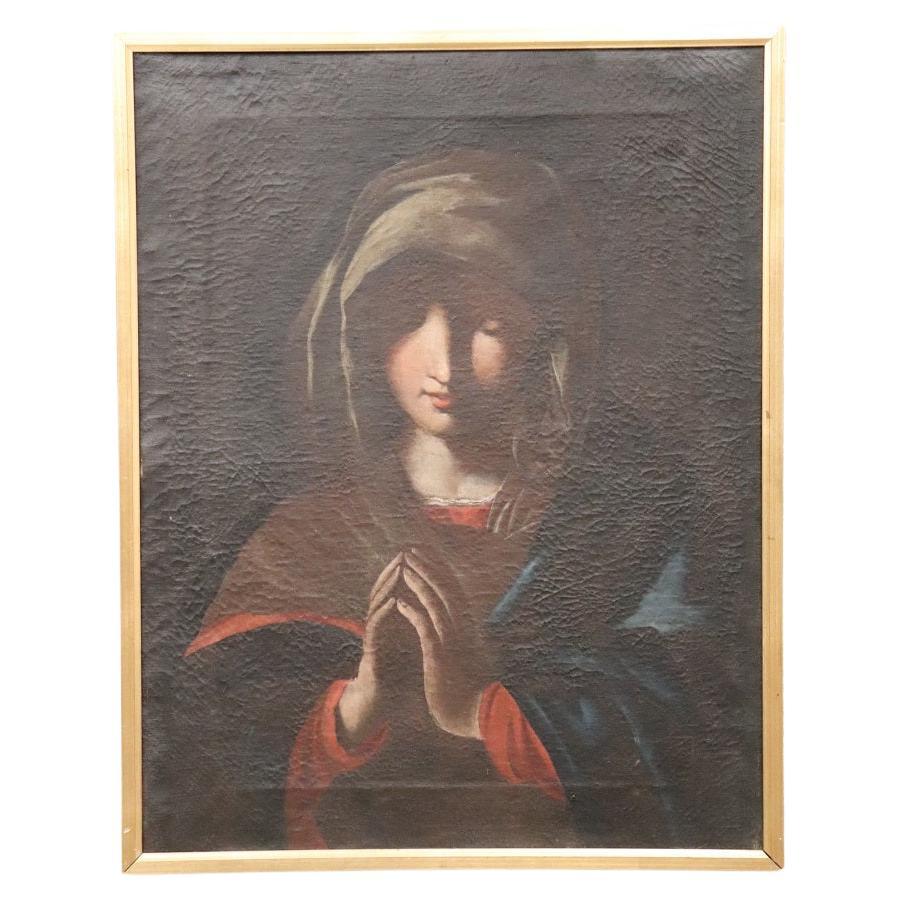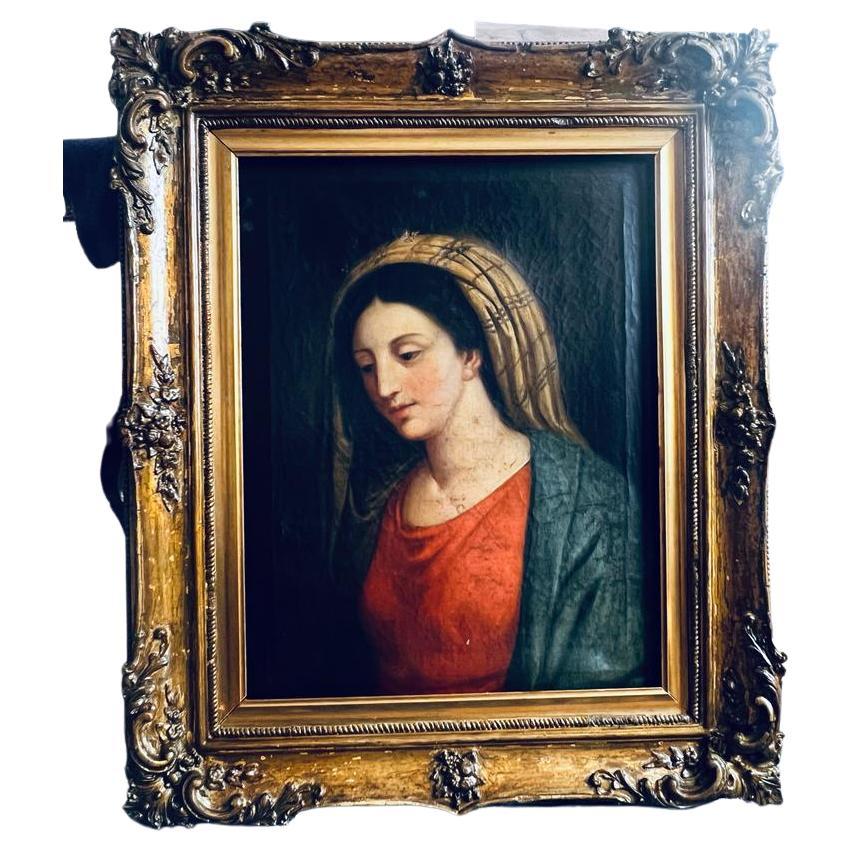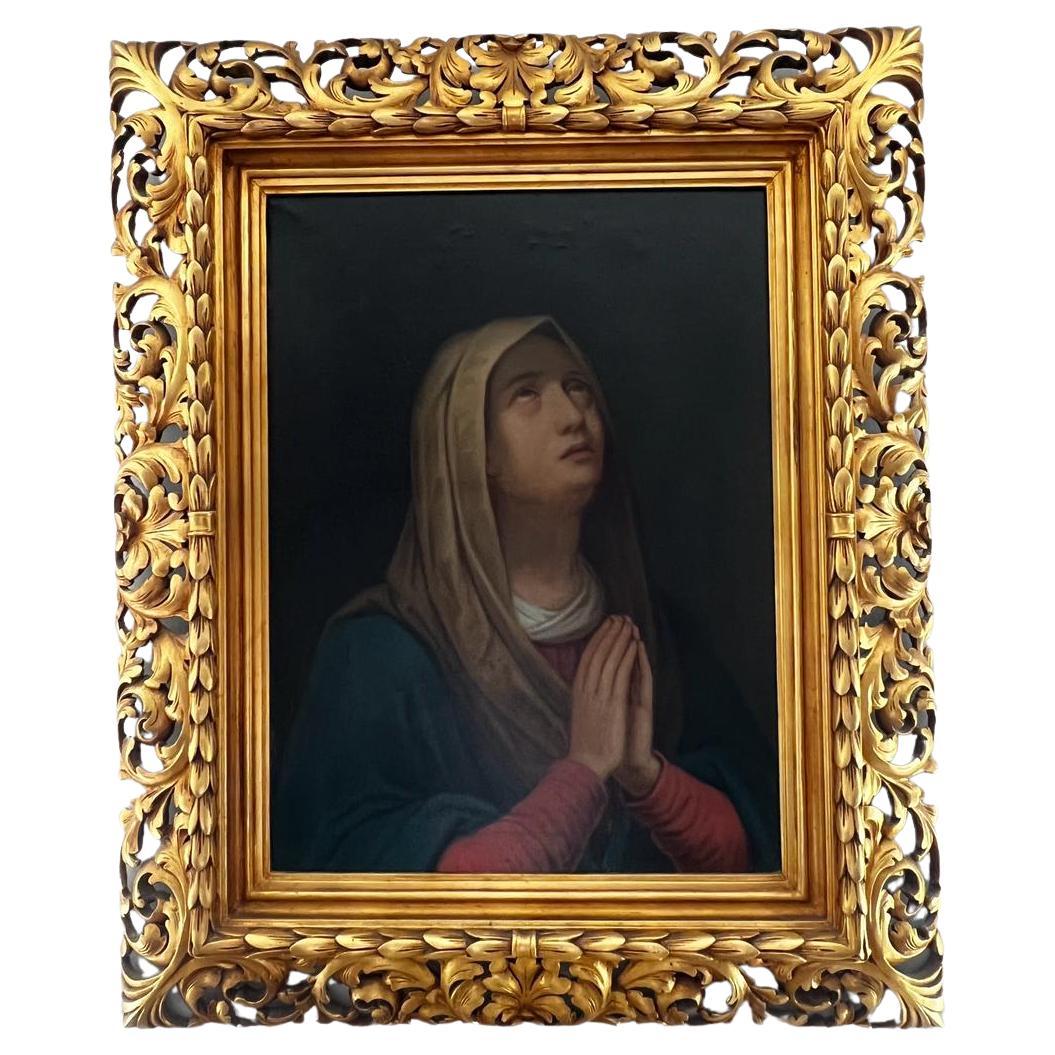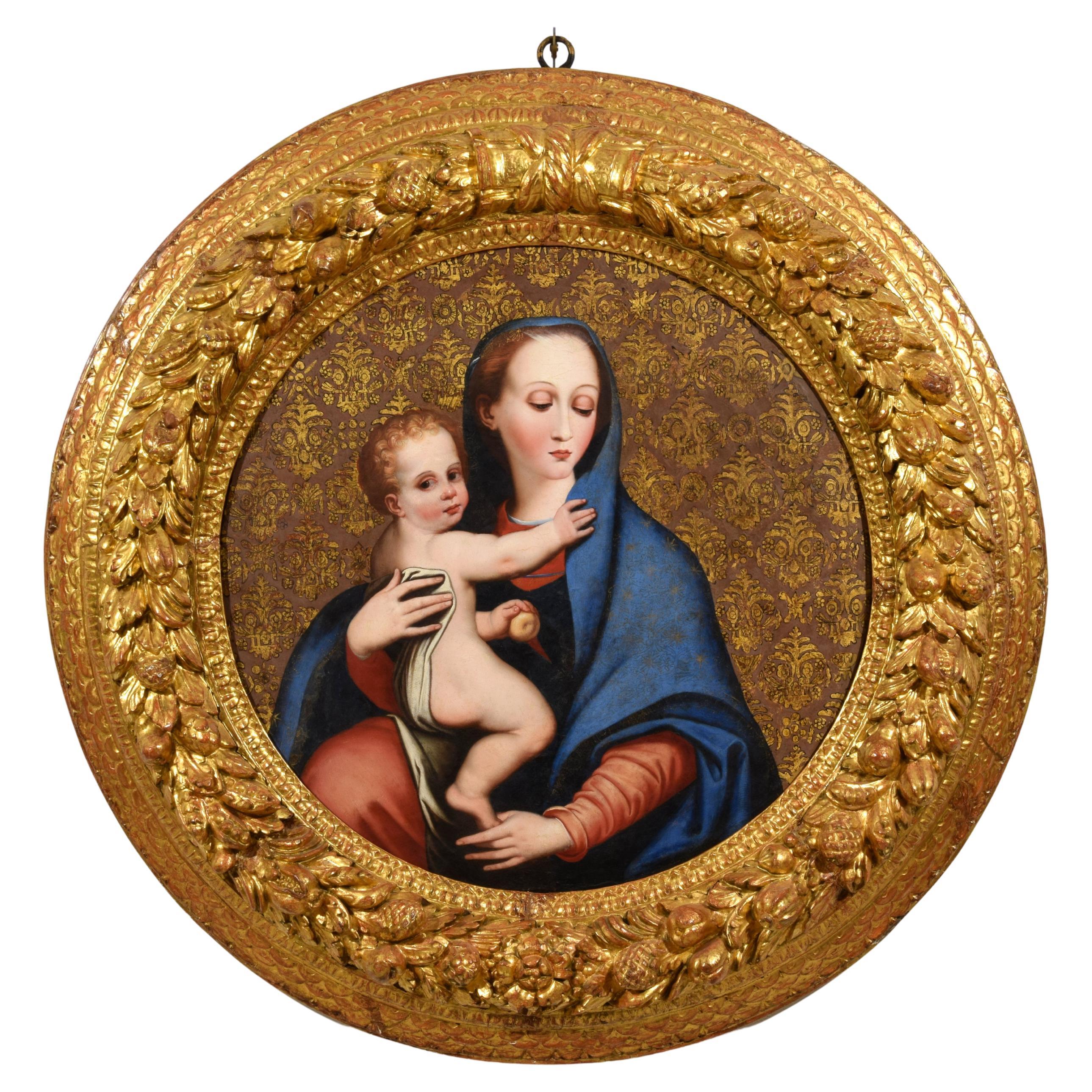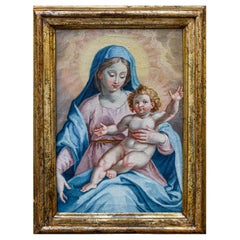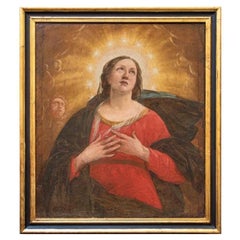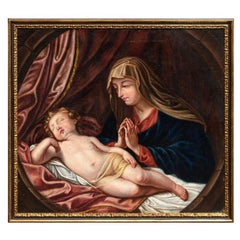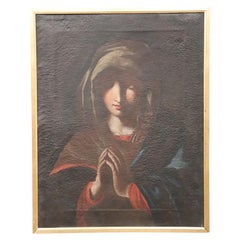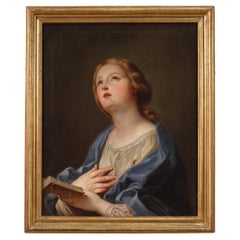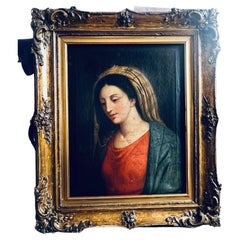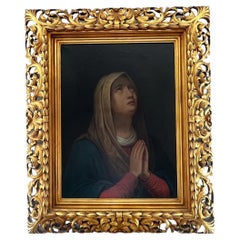Items Similar to Early 17th Century Roman School Praying Madonna Painting Oil on Canvas
Want more images or videos?
Request additional images or videos from the seller
1 of 9
Early 17th Century Roman School Praying Madonna Painting Oil on Canvas
$5,516.22
£4,103.51
€4,600
CA$7,553.60
A$8,398.57
CHF 4,385.27
MX$102,231.06
NOK 55,954.14
SEK 52,426.35
DKK 35,017.26
Shipping
Retrieving quote...The 1stDibs Promise:
Authenticity Guarantee,
Money-Back Guarantee,
24-Hour Cancellation
About the Item
Roman school, late 16th-early 17th century Praying Madonna
Oil on canvas, 81 x 69 cm
Frame 83 x 95.5 cm
A divine whiteness reverberates with vibrant luster on the maphorion of the present Virgin. The palpable iridescence that structures the thin rosaceous garment, woven with the same fresh light, produces a slight rustle when she takes her hands off. The Madonna in fact takes a prayerful pose, opening her palms to underline her fervent ecstatic intention; the white neck is rendered with perishable fullness of pigments, like the hands, perfectly alive, and the very shiny eyes. With fine shrewdness the artist of the present styles the Virgin's hair with thin white ribbons, exacerbating the purity. An evocative light falls gently on the bust, a materialized sign of divine glory.
The present can be traced back to the late Mannerist climate that prevailed in the capital after the emanation of the Tridentine council (1545-1563). The late Mannerist licenses that can still be seen there, such as the intense lyricism in the stylistic code adopted by the artist, are innervated in the new basic catechetical intent, which at the end of the century produced a certain figurative rigorism. The present, however, still responds to that extraordinary Roman dynamism that raised the capital to a bulwark for the entire mannerist lesson, matched only by a second artistic center, the Florentine one. The engaging carriage of the Virgin reflects the contemporary examples of Giuseppe Valeriano (1542-1596), a Jesuit painter, returning in the Marriage of the Virgin of the Roman Church of Jesus, as well as in the Madonna of Sorrows in the Recanati Altarpiece, equal ardor. But it is in the Assumption of the Virgin painted in four hands with Scipione Pulzone (1540 / 2-1584) that the present reveals the greatest assonance. Valeriano attended to the decoration of the Chapel of the Madonna della Strada within the Church of the Gesù, together with the Pulzone, with seven paintings relating to the Stories of the Virgin; the Presentation in the Temple, in particular, offers the same brilliance of clothing that also belongs to the present, of very lucid liquefaction on the outstretched arms of the priest. The gesture of the Virgin, of explicit immediacy, is also equal to that of the agitated Virgin foretold by Marcello Venusti (1512 / 5-1579) of the Rijksmuseum in Amsterdam. It is still up to a work by Scipione Pulzone, the Immaculate Conception for the Church of S. Francesco di Ronciglione (today Museum of Palazzo Doebbing) the interweaving reference, with the painting in question, to the full face of the Madonna. The significant plurality of addresses that occurred in the papal area at the end of the century, encouraged by the need to spread the cultural program of new brotherhoods and religious orders, also justifies the memory of Federico Barocci (1528-1612), significantly similar to Raffaellino Motta called da Reggio (1550-1578) in colorism. The lively modulations of the chromatic range, here with dominant pink tones, were in fact sought, first of all, by Barocci, champion of the Counter-Reformation age; for Barocci the famous Madonna of the cherries are mentioned, while for Motta the Tobiolo and the angel (Galleria Borghese, Rome), of noble and immediate brilliance like the present Madonna. with the painting in question, for the full face of the Madonna. The significant plurality of addresses that occurred in the papal area at the end of the century, encouraged by the need to spread the cultural program of new brotherhoods and religious orders, also justifies the memory of Federico Barocci (1528-1612), significantly similar to Raffaellino Motta called da Reggio (1550-1578) in colorism. The lively modulations of the chromatic range, here with dominant pink tones, were in fact sought, first of all, by Barocci, champion of the Counter-Reformation age; for Barocci the famous Madonna of the cherries are mentioned, while for Motta the Tobiolo and the angel (Galleria Borghese, Rome), of noble and immediate brilliance like the present Madonna. with the painting in question, for the full face of the Madonna. The significant plurality of addresses that occurred in the papal area at the end of the century, encouraged by the need to spread the cultural program of new brotherhoods and religious orders, also justifies the memory of Federico Barocci (1528-1612), significantly similar to Raffaellino Motta called da Reggio (1550-1578) in colorism. The lively modulations of the chromatic range, here with dominant pink tones, were in fact sought, first of all, by Barocci, champion of the Counter-Reformation age; for Barocci the famous Madonna of the cherries are mentioned, while for Motta the Tobiolo and the angel (Galleria Borghese, Rome), of noble and immediate brilliance like the present Madonna. The significant plurality of addresses that occurred in the papal area at the end of the century, encouraged by the need to spread the cultural program of new brotherhoods and religious orders, also justifies the memory of Federico Barocci (1528-1612), significantly similar to Raffaellino Motta called da Reggio (1550-1578) in colorism. The lively modulations of the chromatic range, here with dominant pink tones, were in fact sought, first of all, by Barocci, champion of the Counter-Reformation age; for Barocci the famous Madonna of the cherries are mentioned, while for Motta the Tobiolo and the angel (Galleria Borghese, Rome), of noble and immediate brilliance like the present Madonna. The significant plurality of addresses that occurred in the papal area at the end of the century, encouraged by the need to spread the cultural program of new brotherhoods and religious orders, also justifies the memory of Federico Barocci (1528-1612), significantly similar to Raffaellino Motta called da Reggio (1550-1578) in colorism. The lively modulations of the chromatic range, here with dominant pink tones, were in fact sought, first of all, by Barocci, champion of the Counter-Reformation age; for Barocci the famous Madonna of the cherries are mentioned, while for Motta the Tobiolo and the angel (Galleria Borghese, Rome), of noble and immediate brilliance like the present Madonna. encouraged by the need to spread the cultural program of new brotherhoods and religious orders, it also justifies the memory of Federico Barocci (1528-1612), significantly similar to Raffaellino Motta called da Reggio (1550-1578) in colorism. The lively modulations of the chromatic range, here with dominant pink tones, were in fact sought, first of all, by Barocci, champion of the Counter-Reformation age; for Barocci the famous Madonna of the cherries are mentioned, while for Motta the Tobiolo and the angel (Galleria Borghese, Rome), of noble and immediate brilliance like the present Madonna. encouraged by the need to spread the cultural program of new brotherhoods and religious orders, it also justifies the memory of Federico Barocci (1528-1612), significantly similar to Raffaellino Motta called da Reggio (1550-1578) in colorism. The lively modulations of the chromatic range, here with dominant pink tones, were in fact sought, first of all, by Barocci, champion of the Counter-Reformation age; for Barocci the famous Madonna of the cherries are mentioned, while for Motta the Tobiolo and the angel (Galleria Borghese, Rome), of noble and immediate brilliance like the present Madonna. here with their dominant pink tones, they were in fact sought, first of all, by Barocci, champion of the Counter-Reformation age; for Barocci the famous Madonna of the cherries are mentioned, while for Motta the Tobiolo and the angel (Galleria Borghese, Rome), of noble and immediate brilliance like the present Madonna. here with their dominant pink tones, they were in fact sought, first of all, by Barocci, champion of the Counter-Reformation age; for Barocci the famous Madonna of the cherries are mentioned, while for Motta the Tobiolo and the angel (Galleria Borghese, Rome), of noble and immediate brilliance like the present Madonna.
- Dimensions:Height: 37.6 in (95.5 cm)Width: 32.68 in (83 cm)Depth: 1.97 in (5 cm)
- Materials and Techniques:
- Place of Origin:
- Period:Early 17th Century
- Date of Manufacture:Early 17th Century
- Condition:Refinished. Wear consistent with age and use. The painting has been cleaned.
- Seller Location:Milan, IT
- Reference Number:1stDibs: LU5918226763332
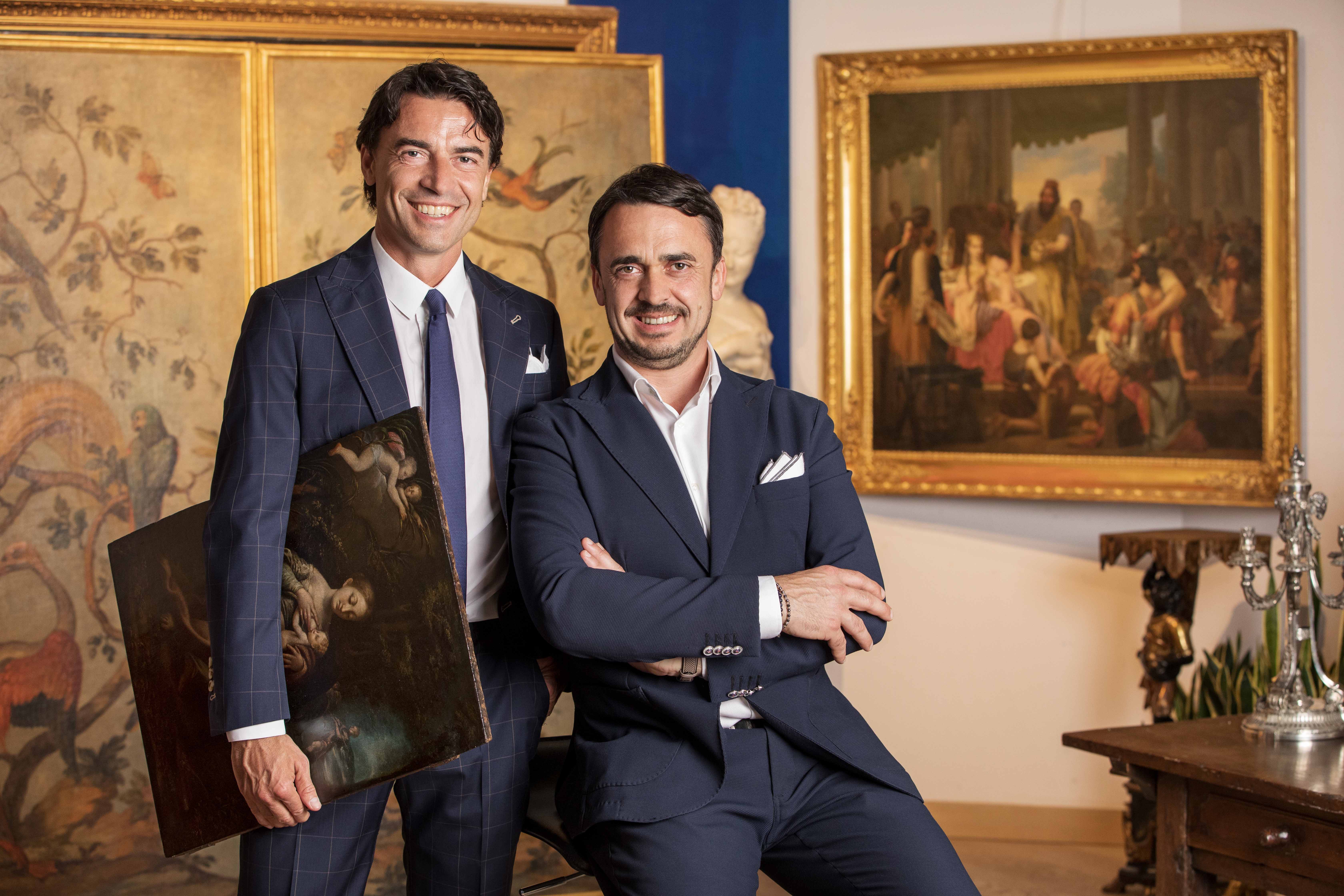
About the Seller
5.0
Vetted Professional Seller
Every seller passes strict standards for authenticity and reliability
Established in 2000
1stDibs seller since 2021
30 sales on 1stDibs
- ShippingRetrieving quote...Shipping from: Milan, Italy
- Return Policy
Authenticity Guarantee
In the unlikely event there’s an issue with an item’s authenticity, contact us within 1 year for a full refund. DetailsMoney-Back Guarantee
If your item is not as described, is damaged in transit, or does not arrive, contact us within 7 days for a full refund. Details24-Hour Cancellation
You have a 24-hour grace period in which to reconsider your purchase, with no questions asked.Vetted Professional Sellers
Our world-class sellers must adhere to strict standards for service and quality, maintaining the integrity of our listings.Price-Match Guarantee
If you find that a seller listed the same item for a lower price elsewhere, we’ll match it.Trusted Global Delivery
Our best-in-class carrier network provides specialized shipping options worldwide, including custom delivery.More From This Seller
View All17th Century Madonna with Child Painting Oil on Canvas Tuscan School
Located in Milan, IT
17th century, Tuscan school
Madonna and Child
Oil on canvas, 31 x 21 cm
With frame, cm 37,5 x 27,5
The pearly incarnations and the thoughtful play of looks between the Virgin, turned to the Son, and Questi, warmly open to the viewer, pour out the present painting with compositional perfection. Virginal fabrics become mottled at the folds, wrapping the Madonna in a thin vitreous mantle. The pastel colors, shining on the pink robe just tightened at the waist by a gold cord, enliven the faces of the divine couple in correspondence of the cheeks, lit by an orange warmth. Even the left hand of the Virgin, composed in perfect classical pose (Botticelli, Madonna with Child, 1467, Musée du Petit Palais, Avignon), is sprinkled with warmth thanks to the immediate touch with Christ. From the nimbus of the Mother a delicate luminous disk is effused, which takes back, in the most distant rays, the colour of the hair of the Son, from the tones of the sun. The Child Jesus is represented intent in a tender gesture of invitation with the right hand, while with the other he offers a universal blessing: with his hand he retracts the index and annular palms, extending the remaining three fingers, symbol of Father, Son and Holy Spirit.
The painting welcomes and re-elaborates that typically Tuscan formalism that boasted in the rest of Italy the constant appreciation by the most up-to-date artists and collectors. Arrangement, composition and mixing of colors place the canvas in the middle between the changing mannerist and the sculptural figures of Michelangelo, essential yardstick of comparison in terms of anatomical and expressionistic rendering. In the present, silvery and pinkish powders act as three-dimensional inducers to the Child’s mentioned musculature and to the vivid folds of the clothes, expertly deposited on the lunar whiteness of the skins. While these colours recall the equally brilliantly transparent colours of Pier Francesco Foschi...
Category
Antique 17th Century Italian Paintings
Materials
Canvas
17th Century Virgin of the Assumption Painting Oil on Canvas
Located in Milan, IT
17th century
Virgin of the Assumption
Oil on canvas, 93 x 81 cm
Frame, 110 x 97 cm
The present Assumption of the Virgin welcomes an innova...
Category
Antique 17th Century Italian Paintings
Materials
Canvas
19th century, from Sassoferrato, Madonna Orante
Located in Milan, IT
19th century, by Giovanni Battista Salvi, known as Sassoferrato (Sassoferrato, 1609 - Rome, 1685)
Praying Madonna
Oil on canvas, 44 x 54 cm
Framed, 88 x 60 cm
Giovanni Battista S...
Category
Antique 19th Century Italian Other Paintings
Materials
Canvas
1848 Madonna Adoring The Sleeping Child Painting Oil on Canvas by Adele Pinot
By Guido Reni
Located in Milan, IT
Adele Pinot (1848), by Guido Reni (Bologna, 1575 - 1642)
Madonna Adoring the Sleeping Child
Oil on canvas, 97 x 107 cm
Signed lower right "Adele Pinot 1848"
The canvas examined depicts the Madonna and Child, caught in a moment of great tenderness and intimacy. Wrapped in a brilliant luminosity, the little Jesus is depicted in the foreground comfortably lying on some soft drapes. The face appears peacefully asleep and is framed by blond curls; the complexion is white and the legs, just curled up and slightly bent at the knee, help to accentuate the naturalness and sweetness of the composition. Full of tenderness and maternal love, the figure of the Madonna appears, with delicate features and a head covered by a veil, which, placed at three quarters, is totally attracted to the contemplation of her little son. The high quality that can be found in the execution of the figures is also emphasized in the rendering of the soft drapery and in the careful attention to detail.
The work, created in 1848 by the French artist Adele Pinot, re-elaborates the famous Madonna in adoration of the Child by Guido Reni (Bologna, 1575 - 1642) now preserved in the Doria Pamphilj...
Category
Antique 19th Century Italian Baroque Revival Paintings
Materials
Canvas
16th Century Madonna of the Carnations Painting Oil on Canvas from Raffaello
By Raphael (Raffaello Sanzio da Urbino)
Located in Milan, IT
16th century, by Raffaello Sanzio (Urbino, 1483 - Rome, 1520)
Madonna of the Carnations
Measures: Oil on canvas 38 x 30 - with frame 59 x 52.5 cm
The Madonna dei Garofani made b...
Category
Antique 16th Century Italian Paintings
Materials
Canvas
16th century Madonna and Child Oil on canvas with gold background
Located in Milan, IT
XVII Century
Madonna and Child
Oil on canvas, 116 x 83 cm
The canvas under consideration depicts the Icon of the Most Holy Virgin Consoled, or more correctly Consoler of the Affl...
Category
Antique 17th Century Decorative Art
Materials
Canvas
You May Also Like
18th Century Italian Antique Oil Painting on Canvas, Madonna in prayer
Located in Casale Monferrato, IT
We are pleased to present this captivating religious painting of the Italian school, painted in oil on canvas in the 18th century. This wonderful painting depicting the Madonna in pr...
Category
Antique 18th Century Italian Paintings
Materials
Canvas
$2,398 Sale Price
20% Off
19th Century Oil on Canvas Italian Antique Religious Painting Praying Madonna
Located in Vicoforte, Piedmont
Wonderful 19th century Italian painting. Oil painting on canvas, first canvas, depicting a splendid praying Madonna who takes as a model a late Baroque devotional composition, presum...
Category
Antique 1850s Italian Paintings
Materials
Canvas
Antique 17th Century Painting Madonna /Virgin Mary Italy Oil on Canvas
Located in Doha, QA
Magnificent Italian 17th century Portrait of Virgin Mary measures 52 x 68 cm without the frame.
The colors are stunning and the paintin...
Category
Antique 17th Century Italian Baroque Paintings
Materials
Canvas
Antique 18th Century Madonna in Sorrow Oil on Canvas, Florentine School
Located in Doha, QA
This antique stunning portrait of Madonna in Sorrow came out from a Palazzo in Florence and an absolute eye catcher. The colors and details are incredible and very typical for an Ita...
Category
Antique Late 18th Century Italian Baroque Paintings
Materials
Canvas
17th Century, Italian Oil on Panel Painting Depicting Madonna della Purità
Located in IT
17th Century, Italian Oil on Panel Painting Depicting Madonna della Purità
The painting, executed in oil on a circular wooden panel and presented in an imposing carved and gilded wo...
Category
Antique 17th Century Italian Renaissance Paintings
Materials
Wood, Giltwood
Beautiful 17th Century Italian School " Virgin of Sorrows "
Located in Madrid, ES
Beautiful 17th century Italian school " Virgin of Sorrows "
Oil on canvas
Measures : 50.5 x 42.5 cm
very good condition
Category
Antique Mid-17th Century Italian Baroque Paintings
Materials
Paint
More Ways To Browse
Immaculate Conception
Jesus Praying
Praying Angel
Borghese Bust
Used Furniture North Shore Ma
Victor Petre
Vintage Magnolia Mirror
Vintage Vanguard Lee Reynolds
Weinstein Gallery
Wyatt Earp
Xavier Wurth
A Rangel Hidalgo Painting
Adolf Menzel
Albert Namatjira
Albert Radoczy
Alessandro La Volpe
Alessandro Magnasco
Alexander Canedo
